(3889 products available)









































































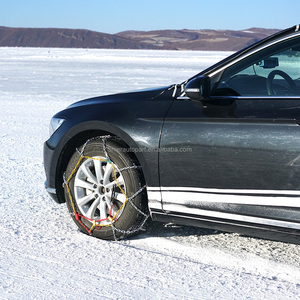














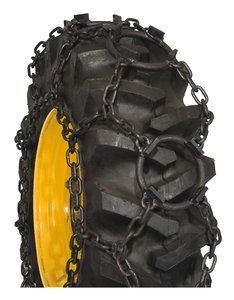
























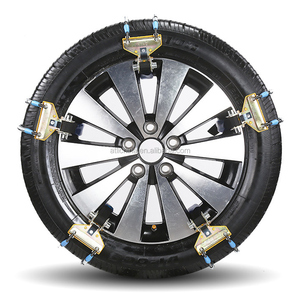



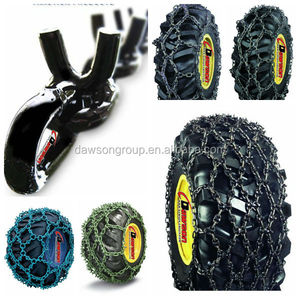


















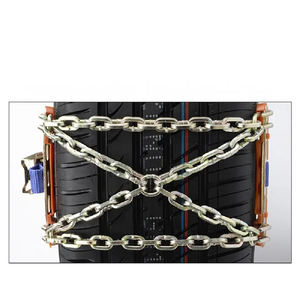


















































Chain snow tires are specialized tires used for driving in snowy and icy conditions. They offer better traction on slippery roads, reducing the risk of accidents. There are different types of chain snow tires, including:
Link chains
Link chains are the most common type of snow chains. They consist of metal links arranged in a square pattern. This design provides excellent traction on icy roads. Link chains come in different sizes to fit various tire sizes. They are easy to install and remove manually. Some link chains have self-tightening features. This feature keeps the chains securely fitted around the tires without requiring adjustments.
Diamond pattern chains
Diamond pattern chains feature a diamond-shaped arrangement of the chain. This design allows the chains to make contact with the road in a gliding manner. This reduces wear on the chains and the tires. Diamond pattern chains provide superior traction on both ice and deep snow. They also offer better handling compared to link chains. However, diamond pattern chains are more expensive and may require professional installation.
Cable chains
Cable chains are an alternative to traditional link chains. Instead of metal links, cable chains use thick steel cables. The cables are wrapped around the tires in a spiral pattern. This design provides enough traction for most winter conditions, especially in areas with occasional snow. Cable chains are lighter and less expensive than link chains. They are also easier to install. However, cable chains do not perform as well on ice or deep snow as link chains.
Spiral chains
Spiral chains are similar in construction to cable chains. They also use steel cables wrapped around the tires. However, the cables in spiral chains are arranged in a spiral pattern. This design increases the surface area of the chains that contacts the road. As a result, spiral chains provide better traction on slippery roads. Spiral chains are suitable for vehicles that require frequent snow chain installation. For example, trucks and commercial vehicles that operate in snowy regions.
Automatic chains
Automatic chains are a high-tech solution for winter driving. These chains can be installed and uninstalled automatically with the push of a button. This feature allows drivers to engage the chains while driving. For example, when entering a highway from an exit road. Automatic chains are convenient for vehicles that frequently transition between dry and snowy roads. However, they are the most expensive type of snow chains.
Here is the general specification of a chain snow tire:
Link size
Link size is the diameter of the chain links. It ranges from 1/8 inches to 1/4 inches. Larger link sizes are more durable and suitable for heavy-duty applications. Smaller link sizes offer better traction on icy roads.
Chain type
There are different types of snow chains. For example, cable chains offer a lighter and more affordable alternative to traditional chains. They are not as durable as chain snow tires. Diamond pattern chains have a grid-like diamond pattern. They offer superior traction.
Material
Snow chains are usually made from steel. Some chains are made from manganese or tungsten. Manganese chains are more affordable than steel chains. They offer better performance than cable chains. Tungsten chains are more durable than steel chains. They are suitable for extreme winter conditions.
Vehicle compatibility
Snow chains are designed for specific vehicles. For example, there are chains for passenger vehicles, light trucks, and SUVs. Each vehicle has a recommended chain size. The chains must be fitted properly to avoid damage to the vehicle and the chain.
Load rating
The load rating of a snow chain indicates the maximum weight it can support. The load rating of snow chains ranges from 1,000 pounds to 5,000 pounds. Heavier chains offer more durability and strength.
Here are some maintenance tips for chain snow tires:
A number of factors need to be considered before purchasing snow chains for cars.
Vehicle Type and Size
Business buyers should consider the type and size of their vehicles when choosing tire chains. This is because different vehicles have different clearance limits. The snow chain for a compact car may not fit properly on the tires of a heavy-duty truck. Ideally, the vehicle's make, model, and year of production should be taken into consideration. The width and diameter of the tires should also be checked.
Driving Needs and Conditions
Consider the usual driving conditions and road types when purchasing snow chains. Do the roads get heavy snowfall? Or are they paved with a light coating of ice? For frequent drivers on roads with heavy snow and steep hills, deep and aggressive chains are a great choice. Those who drive occasionally on icy streets, on the other hand, would benefit more from easier-to-install and remove chains.
Chain Clearance
Before purchasing tire chains, ensure there is adequate clearance between the tires and the vehicle's body or suspension. This is because some chains require more space to fit properly. The last thing any driver wants is for the chains to rub against and damage the vehicle.
Material and Durability
Chain snow tires are usually made of hardened steel. However, some chains have alloy materials that offer better performance in snowy conditions. Alloy chains tend to be lighter and more resistant to corrosion. This makes them suitable for use in coastal areas with salty water. Consider the material and durability of the chains based on the area where they will be used.
Ease of Installation
If possible, business buyers should get tire chains that are easy to install and remove. This is especially important for occasional use. Some chains come with tensioning systems that ensure they fit properly on the tires. There are also self-install chains that stay securely on the tires. Whichever chain is purchased, ensure it is easy to install and remove in case the vehicle encounters a snowy road.
Legal Requirements
Before purchasing snow chains, business buyers should check the local laws regarding their use. Some areas, especially those with high mountains, require chains during winter. Additionally, different regions have specific regulations about chain types and sizes. Ensure the chains comply with all the required standards.
Budget and Quality
Typically, chain snow tires come in different qualities and prices. To get a good deal, business buyers should balance quality and budget. Get chains from reputable brands with high quality. This way, the chains can offer a long service life and optimal performance. Remember, cheap is expensive.
Storage and Maintenance
Consider how the chains will be stored when not in use. They should be protected from moisture and dirt to prevent damage. Furthermore, inspect the chains regularly for signs of wear. Clean them after every use and lubricate them properly.
Installing snow chains on tires can be a simple DIY process. Here are the steps to follow:
Preparation
When embarking on a DIY project, ensure that the proper tools are available for use. In this case, lay out the snow chains and ensure they are not tangled. To be prepared for the installation, read the instructions that come with the chains. Drive a few times on a flat surface before driving on the road to ensure the chains are working properly and installed correctly.
Placement
Once the vehicle has been parked in a safe location, the snow chains should be placed on the tires that are driving the vehicle. For front-wheel drive cars, the chains should be placed on the front tires. Mount the chains over the tire's top and then work the sides and back. Make sure the chains are evenly distributed and that they sit properly on the tire.
Adjustment
After installing the snow chains, it is important to drive for a few miles and then check the tightness. The snow chains should be tightly fitted on the tires but not excessively tight to the point where they damage the tire. Adjust the chains accordingly to ensure a proper fit.
Q1: Do chain tires damage roads?
A1: Generally, tire chains do not damage roads. However, when used inappropriately, such as on dry pavements, they can cause some wear and tear. Nonetheless, the advantages of enhanced traction in adverse weather conditions typically outweigh any minimal road impact.
Q2: Are chain snow tires good for winter?
A2: Yes, chain snow tires are suitable for winter, especially in areas with heavy snow and ice. They provide excellent traction and can handle challenging winter conditions, ensuring safety and stability for vehicles.
Q3: How long do snow chains last?
A3: The lifespan of snow chains can vary depending on usage, maintenance, and frequency of the conditions. With proper maintenance and typical seasonal use, snow chains can endure for several seasons. However, inspecting them regularly and replacing any worn or damaged components as needed is essential to ensure optimal performance and safety.
Q4: Can snow chains be used on all vehicles?
A4: Snow chains can be applied to most vehicles, including cars, trucks, and SUVs. However, selecting the right size and type of chains suitable for the specific vehicle's tires is essential.
Q5: Are chain tires suitable for off-road use?
A5: Yes, chain tires are appropriate for off-road conditions, mainly when the terrain is challenging, such as in deep mud, sand, or rocky areas. The chains improve traction and stability, making it easier to navigate difficult paths.
The web search volume for the keyword "chain snow tire" has demonstrated significant fluctuations over the past year, with an average monthly web search volume of 49,500. Notably, the web search volume peaked in February 2024 at 201,000 web searches, while the lowest point was in June 2024 with only 9,900 web searches. This trend reflects a substantial three-month change of 174% and a one-year change of -45%.
Analyzing the monthly data, the web search volume for "chain snow tire" typically begins to increase in December, reaching its zenith in February, and then gradually declines as the winter season wanes. The peak in February can be attributed to the heightened demand for snow tires during the coldest months in regions experiencing heavy snowfall. Conversely, the decline starting in March and continuing into the summer months aligns with the seasonal reduction in snow-related weather events.
This seasonal pattern is consistent with consumer behavior, where purchases of winter-specific vehicle accessories like chain snow tires spike as drivers prepare for winter conditions and then taper off as the weather warms. The data clearly illustrates the direct correlation between weather patterns and consumer search behavior, emphasizing the importance of seasonality in marketing strategies for vehicle parts and accessories.